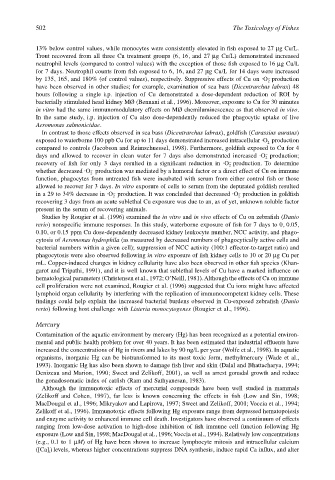Page 522 - The Toxicology of Fishes
P. 522
502 The Toxicology of Fishes
13% below control values, while monocytes were consistently elevated in fish exposed to 27 µg Cu/L.
Trout recovered from all three Cu treatment groups (6, 16, and 27 µg Cu/L) demonstrated increased
neutrophil levels (compared to control values) with the exception of those fish exposed to 16 µg Cu/L
for 7 days. Neutrophil counts from fish exposed to 6, 16, and 27 µg Cu/L for 14 days were increased
–
by 135, 165, and 180% (of control values), respectively. Suppressive effects of Cu on ·O production
2
have been observed in other studies; for example, examination of sea bass (Dicentrarchus labrax) 48
hours following a single i.p. injection of Cu demonstrated a dose-dependent reduction of ROI by
bacterially stimulated head kidney MØ (Bennani et al., 1996). Moreover, exposure to Cu for 30 minutes
in vitro had the same immunomodulatory effects on MØ chemiluminescence as that observed in vivo.
In the same study, i.p. injection of Cu also dose-dependently reduced the phagocytic uptake of live
Aeromonas salmonicidae.
In contrast to those effects observed in sea bass (Dicentrarchus labrax), goldfish (Carassius auratus)
–
exposed to waterborne 100 ppb Cu for up to 11 days demonstrated increased intracellular ·O production
2
compared to controls (Jacobson and Reimschuessel, 1998). Furthermore, goldfish exposed to Cu for 4
–
days and allowed to recover in clean water for 7 days also demonstrated increased ·O production;
2
–
recovery of fish for only 3 days resulted in a significant reduction in ·O production. To determine
2
–
whether decreased ·O production was mediated by a humoral factor or a direct effect of Cu on immune
2
function, phagocytes from untreated fish were incubated with serum from either control fish or those
allowed to recover for 3 days. In vitro exposure of cells to serum from the depurated goldfish resulted
–
–
in a 29 to 34% decrease in ·O production. It was concluded that decreased ·O production in goldfish
2
2
recovering 3 days from an acute sublethal Cu exposure was due to an, as of yet, unknown soluble factor
present in the serum of recovering animals.
Studies by Rougier et al. (1996) examined the in vitro and in vivo effects of Cu on zebrafish (Danio
rerio) nonspecific immune responses. In this study, waterborne exposure of fish for 7 days to 0, 0.05,
0.10, or 0.15 ppm Cu dose-dependently decreased kidney leukocyte number, NCC activity, and phago-
cytosis of Aeromonas hydrophila (as measured by decreased numbers of phagocytically active cells and
bacterial numbers within a given cell); suppression of NCC activity (100:1 effector-to-target ratio) and
phagocytosis were also observed following in vitro exposure of fish kidney cells to 10 or 20 µg Cu per
mL. Copper-induced changes in kidney cellularity have also been observed in other fish species (Khan-
garot and Tripathi, 1991), and it is well known that sublethal levels of Cu have a marked influence on
hematological parameters (Christensen et al., 1972; O’Neill, 1981). Although the effects of Cu on immune
cell proliferation were not examined, Rougier et al. (1996) suggested that Cu ions might have affected
lymphoid organ cellularity by interfering with the replication of immunocompetent kidney cells. These
findings could help explain the increased bacterial burdens observed in Cu-exposed zebrafish (Danio
rerio) following host challenge with Listeria monocytogenes (Rougier et al., 1996).
Mercury
Contamination of the aquatic environment by mercury (Hg) has been recognized as a potential environ-
mental and public health problem for over 40 years. It has been estimated that industrial effluents have
increased the concentrations of Hg in rivers and lakes by 90 ng/L per year (Wolfe et al., 1998). In aquatic
organisms, inorganic Hg can be biotransformed to its most toxic form, methylmercury (Wade et al.,
1993). Inorganic Hg has also been shown to damage fish liver and skin (Dalal and Bhattacharya, 1994;
Denizeau and Marion, 1990; Sweet and Zelikoff, 2001), as well as arrest gonadal growth and reduce
the gonadosomatic index of catfish (Ram and Sathyanesan, 1983).
Although the immunotoxic effects of mercurial compounds have been well studied in mammals
(Zelikoff and Cohen, 1997), far less is known concerning the effects in fish (Low and Sin, 1998;
MacDougal et al., 1996; Mikryakov and Lapirova, 1997; Sweet and Zelikoff, 2001; Voccia et al., 1994;
Zelikoff et al., 1996). Immunotoxic effects following Hg exposure range from depressed hematopoiesis
and enzyme activity to enhanced immune cell death. Investigators have observed a continuum of effects
ranging from low-dose activation to high-dose inhibition of fish immune cell function following Hg
exposure (Low and Sin, 1998; MacDougal et al., 1996; Voccia et al., 1994). Relatively low concentrations
(e.g., 0.1 to 1 µM) of Hg have been shown to increase lymphocyte mitosis and intracellular calcium
([Ca] ) levels, whereas higher concentrations suppress DNA synthesis, induce rapid Ca influx, and alter
i

